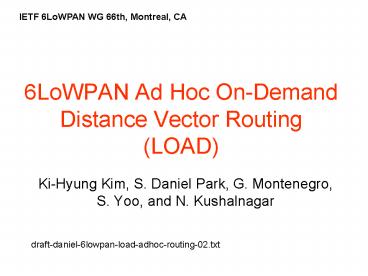6LoWPAN Ad Hoc On-Demand Distance Vector Routing (LOAD) - PowerPoint PPT Presentation
Title:
6LoWPAN Ad Hoc On-Demand Distance Vector Routing (LOAD)
Description:
6LoWPAN Ad Hoc On-Demand Distance Vector Routing (LOAD) ... By Pere Salvatella, Wireless Networks Group, Technical University of Catalonia (UPC) ... – PowerPoint PPT presentation
Number of Views:209
Avg rating:3.0/5.0
Title: 6LoWPAN Ad Hoc On-Demand Distance Vector Routing (LOAD)
1
6LoWPAN Ad Hoc On-Demand Distance Vector Routing
(LOAD)
IETF 6LoWPAN WG 66th, Montreal, CA
- Ki-Hyung Kim, S. Daniel Park, G. Montenegro, S.
Yoo, and N. Kushalnagar
draft-daniel-6lowpan-load-adhoc-routing-02.txt
2
Mesh Routing underneath to IPv6 Layer
Application
Application
Application
Transport
Transport
Transport
IPv6
IPv6
IPv6
Adaptation
Adaptation
Adaptation
802.15.4 MAC
802.15.4 MAC
802.15.4 MAC
PHY
PHY
PHY
3
LoWPAN Optimizations
- Sub-IP Routing
- Allows efficient header compression, smaller
route tables - Use EUI-64 or 16 bit addresses
- Use prot_type field to indicate AODV control
messages instead of UDP ports - Utilization of 6lowpan characteristics
- Use the route cost by utilizing the LQI of the
6LoWPAN PHY - Allow multiple schemes such as hop counts,
aggregated LQI values, and minimum LQI value
along a route - Hello messages are not used, instead use 802.15.4
link layer mechanisms such as ACKs, beacon
responses, overhearing packets, etc - Use broadcast in the route discovery
4
LoWPAN Optimizations II
- Minimize power consumption and complexity
- Do not use the destination sequence number
- Only destination Replies to RREQ by RREP
- Do not use the local repair
- Report back to the originator by RERR upon a link
break - Do not maintain the precursorlist
- Send RERR only to the originator of the data
which caused the link break - Utilize Efficient RERR reporting
- Reuse existing specs, such as AODV and DYMO, as
much as possible
5
Change Log
- Define the route cost by LQI and weak links
- Hop counts while avoiding weak links
- Several comments
- Default value of weak LQI ? Is there a systematic
way to determine it - The necessity of the sequence number
- To prevent a routing loop ? Only destination
replies to RREQ - Sequence numbers could also be used as an
indicator of the freshness of routes ? Sequence
number could be beneficial for routing ability - Interaction between QoS metric and distance
vector routing (Introduction of weak links in
addition to the hop count) - Lifetime definition
- Link monitoring (route timeout by timers?) ?
should consider the expiration policy of routing
entries based on energy consumption - Weak link indicator by LQI
- Unidirectional links?
- RERR for low battery and route cost not
supported should be avoided
6
LOAD/DYMO-low Implementations in Progress
- By Pere Salvatella, Wireless Networks Group,
Technical University of Catalonia (UPC) - ------------------------------------------
--- Aplication Layer (WebServer,
TelnetServer) --------------------------
------------------- IP Layer
(uIP IPv4 Stack TCP/UDP)
---------------------------------------------
Routing Layer (DYMO-low, LOAD)
-------------------------------------
-------- 6lowpan header (simplified
version) ---------------------------
------------------ Physical Layer
(IEEE 802.15.4 radio)
---------------------------------------------
7
Prototype Implementation
- http//www.6lowpan.org
- Test bed Implementation
- Segmentation and Reassembly
- Header compression (Format document)
- Gateway between 6lowpan and IPv6 networks
- LOAD/DYMO-low
- Hi-Low
8
Overall Architecture of the 6lowpan Testbed
9
Protocol stack of 6lowpan router
10
Performance Results of LOAD/DYMO-low
11
Topology for Testing
12
Identifying Weak Links
13
Delivery Ratio
14
Transmission Delay
15
Summary
- Feedback is welcome
- Accept it as a WG item ?










![[AD Hoc Networks] PowerPoint PPT Presentation](https://s3.amazonaws.com/images.powershow.com/8371435.th0.jpg?_=20161231113)




















